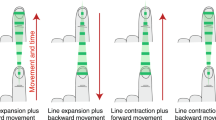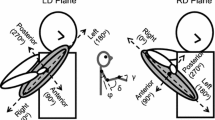Abstract
According to the radial-tangential illusion, in the horizontal plane, arm movements executed in directions radial to the trunk are sensed to be longer than movements of the same length in the orthogonal direction. It has been suggested that the illusion arises from the fact that radially directed movements are executed more slowly and require more effort. These suggestions were tested in a series of experiments, using a robotically controlled manipulandum. In all of the experiments subjects grasped the handle of the manipulandum, in some cases exploring the virtual boundary of a rectangle, while in others being guided along a rectangular contour by the robot. In a two-alternative forced choice design, subjects reported whether the rectangle was wide or narrow. In a control experiment, subjects manifested the radial-tangential illusion. Contrary to the hypothesis, the magnitude of this illusion was not altered when a resistive force was added in the tangential direction or when the ratio of movement times in the tangential and radial directions was changed. However, when the contour was explored in the counterclockwise direction, the illusion was much smaller than when it was explored in the clockwise direction. A second series of experiments, in which subjects only explored two sides (i.e., an L-shape), demonstrated that this effect arose from distortions induced by the serial ordering of the exploratory movements. The illusion was much smaller when the radial segment was explored first. We suggest that this distortion arises from the serial nature of haptic exploration, in which the length of the initial segment decreases as it is stored in working memory for subsequent comparison.







Similar content being viewed by others
References
Armstrong L, Marks LE (1999) Haptic perception of linear extent. Percept Psychophys 61:1211–1226
Cheng MF (1968) Tactile-kinesthetic perception of length. Am J Psychol 81:74–82
Davidon RS, Cheng M-F (1964) Apparent distance in a horizontal plane with tactile-kinesthetic stimuli. Q J Exp Psychol 16:277–281
Day RH, Avery GC (1970) Absence of the horizontal–vertical illusion in haptic space. J Exp Psychol 83:172–17
Deregowski J, Ellis HD (1972) Effect of stimulus orientation upon haptic perception of the horizontal–vertical illusion. J Exp Psychol 95:14–19
Fasse ED, Hogan N, Kay BA, Mussa-Ivaldi FA (2000) Haptic interaction with virtual objects. Biol Cybern 82:69–83
Flanagan JR, Lolley S (2001) The inertial anisotropy of the arm is accurately predicted during movement planning. J Neurosci 21:1361–1369
Gandevia SC, McCloskey DI, Burke D (1992) Kinaesthetic signals and muscle contraction. Trends Neurosci 15:62–65
Gentaz E, Hatwell Y (2004) Geometrical haptic illusions: the role of exploration in the Muller-Lyer, vertical–horizontal, and Delboeuf illusions. Psychon Bull Rev 11:31–40
Gnadt JW, Bracewell RM, Andersen RA (1991) Sensorimotor transformation during eye movements to remembered visual targets. Vision Res 31:693–715
Goodwin AW, Wheat HE (2004) Sensory signals in neural populations underlying tactile perception and manipulation. Annu Rev Neurosci 27:53–77
Hatwell Y (1960) Ètude de quelques illusions géométriques tactiles chez les aveugles. L’année Psychol 1:11–27
Heller MA, Calcaterra JA, Burson LL, Green SL (1997) The tactual horizontal–vertical illusion depends on radial motion of the entire arm. Percept Psychophys 59:1297–1311
Henriques DY, Soechting JF (2003) Bias and sensitivity in the haptic perception of geometry. Exp Brain Res 150:95–108
Henriques DY, Soechting JF (2005) Approaches to the study of haptic sensing. J Neurophysiol 93:3036–3043
Henriques DY, Flanders M, Soechting JF (2004) Haptic synthesis of shapes and sequences. J Neurophysiol 91:1808–1821
Hogan N, Kay BA, Fasse ED, Mussa-Ivaldi FA (1990) Haptic illusions: experiments on human manipulation and perception of “virtual objects. Cold Spring Harb Symp Quant Biol 55:925–931
Kesten H (1958) Accelerated stochastic approximation. Ann Math Stat 29:41–59
Lederman SJ, Klatzky RL, Collins A, Wardell J (1987) Exploring environments by hand or foot: time-based heuristics for encoding distance in movement space. J Exp Psychol Learn Mem Cogn 13:606–614
Marchetti FM, Lederman SJ (1983) The haptic radial-tangential effect—2 tests of Wong’s moments-of-inertia hypothesis. Bull Psychon Soc 21:43–46
McIntyre J, Stratta F, Lacquaniti F (1998) Short-term memory for reaching to visual targets: psychophysical evidence for body-centered reference frames. J Neurosci 18:8423–8435
Millar S, Al-Attar Z (2000) Vertical and bisection bias in active touch. Perception 29:481–500
Millar S, Al-Attar Z (2004) External and body-centered frames of reference in spatial memory: evidence from touch. Percept Psychophys 66:515–519
Paillard J, Brouchon M (1968) Active and passive movements in the calibration of position sense. In: Freedman SJ (eds) The neuropsychology of spatially oriented behavior. Dorsey, Homewood, pp 37–55
Revesz G (1950) Psychology and art of the blind. Longmans Green, London
Robles-De-La-Torre G, Hayward V (2001) Force can overcome object geometry in the perception of shape through active touch. Nature 412:445–448
Romo R, Salinas E (2001) Touch and go: decision-making mechanisms in somatosensation. Annu Rev Neurosci 24:107–137
Romo R, Hernandez A, Zainos A, Lemus L, Brody CD (2002) Neuronal correlates of decision-making in secondary somatosensory cortex. Nat Neurosci 5:1217–1225
Romo R, Hernandez A, Zainos A (2004) Neuronal correlates of a perceptual decision in ventral premotor cortex. Neuron 41:165–173
Soechting JF, Poizner H (2005) The use of motion cues in the haptic sense of circularity. Exp Brain Res 165:413–421
Soechting JF, Buneo CA, Herrmann U, Flanders M (1995) Moving effortlessly in three dimensions: does Donders’ law apply to arm movement? J Neurosci 15:6271–6280
Treutwein B (1995) Adaptive psychophysical procedures. Vision Res 35:2503–2522
Wong TS (1977) Dynamic properties of radial and tangential movements as determinants of the haptic horizontal–vertical illusion with an L figure. J Exp Psychol Hum Percept Perform 3:151–164
Wydoodt P, Gentaz E, Streri A (2006) Role of force cues in the haptic estimations of a virtual length. Exp Brain Res 171:481–489
Acknowledgments
We thank Dr. Martha Flanders for helpful discussions during the course of this work.
This work was supported by NIH Grant NS15018.
Author information
Authors and Affiliations
Corresponding author
Rights and permissions
About this article
Cite this article
McFarland, J., Soechting, J.F. Factors influencing the radial-tangential illusion in haptic perception. Exp Brain Res 178, 216–227 (2007). https://doi.org/10.1007/s00221-006-0727-9
Received:
Accepted:
Published:
Issue Date:
DOI: https://doi.org/10.1007/s00221-006-0727-9




